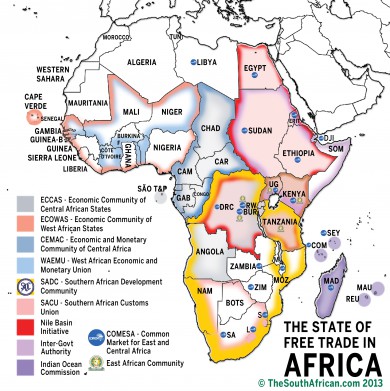Africa’s "grand" FTA negotiation progressing well: SADC officials

Xinhua | 16 August 2014
Africa’s "grand" FTA negotiation progressing well: SADC officials
VICTORIA FALLS, Zimbabwe, Aug. 16 (Xinhua) — Negotiations to set up a grand free trade zone encompassing 26 countries in eastern and southern Africa are progressing well and may be completed in 2015, a year before schedule, officials with Southern African Development Community (SADC), one of the three participating regional blocs, have revealed.
The Tripartitie Free Trade Agreeement (Tripartitie FTA), being negotiated among SADC, Common Market for Eastern and Southern Africa (COMESA), and East African Community (EAC), is expected to benefit 600 million people in 26 African countries, or half of the African Union (AU) members, with a combined domestic product of about 1 trillion U.S. dollars.
Once in effect, the tripartite FTA will create Africa’s largest integrated market so far.
SADC Director of Trade, Industry, Finance and Investment, Boitumelo Gofhamodimo said on eve of the SADC Heads of States and Governments Summit to be held this weekend at the Zimbabwean resort town of Victoria Falls that southern Africa is ready for the establishment of the Tripartite FTA.
"We expect to conclude the negotiations by end of the year," Gofhamodimo said. "It is one arrangement which is very important in boosting trade and deepening integration."
Gofhmodimo said apart from offering a bigger market, the FTA allows countries in eastern and southern Africa to harmonize their trade policies.
SADC Executive Secretary Stergomena Lawrence Tax said if everything goes well, the FTA can be launched in 2015.
According to a roadmap adopted by COMESA-EAC-SADC in 2011, the FTA was initially expected to come into force by 2016. Negotiation for the second of the three phrases is about to start and will focus on issues like trade in services and trade-related issues such as intellectual property rights, competition policy and trade development and competitiveness.
Parties are wrapping up the first phrase talks which touch "core FTA issues" such as tariff liberalization, rules of origin, customs procedures and simplification of customs documentation, transit procedures, non-tariff barriers, trade remedies and other technical barriers to trade and dispute resolution, according to the Southern African Research and Documentation Centre (SARDC), a regional research body.
Kizito Sikuka, a researcher of the SARDC, said the ultimate launch of the enlarged FTA will result in the three sub-regions coalescing into a single FTA with the goal of establishing a single Customs Union in the near future.
"Intra-regional trade in this part of Africa is expected to increase sharply and deepen regional integration through improved investment flows and enhanced competition," he said, adding that removal of trade barriers such as huge export and import fees would enable countries to increase their earnings, penetrate new markets and contribute towards their national development.
The SADC, meanwhile, is consolidating its own FTA which covers all but three SADC member states — Angola, Democratic Republic of Congo and Seychelles.
The SADC FTA was launched in 2008, but maximum liberalization among participating member states was eventually realized in 2012 when tariffs on sensitive products were removed.
Gofhamodimo revealed that Seychelles was now ready to join the SADC FTA after its offer to remove all tariffs on goods to promote the smooth movement of goods and services across the region.
"Although not so big, regional trade (among the 12 SADC FTA members) has increased from 13.8 billion U.S. dollars in 2000 to 58 billion U.S. dollars in 2012," Gofhamodimo said.
In the SADC region, South Africa is the largest trading partner, with its exports to the region accounting for 40 percent of total intra-regional trade. Other major exporting countries include Angola, Zambia and Zimbabwe.
Tax said she hoped the tripartite FTA would address the issue of overlapping membership of countries in the COMESA, EAC and SADC.
Zambia, Zimbabwe, Malawi, Mauritius, for example, belong to both COMESA and SADC, while Kenya, Uganda, Rwanda, and Burundi belong to both EAC and COMESA.
The SADC had missed its target to launch a customs union in 2010, and is likely to miss other integrated market targets like a common market by 2015, a monetary union by 2016 and a single currency by 2018.
"Why have we failed to reach other stages of integration? It is the issue of multiple members. It becomes a challenge (for a country) to be in more than one customs union," Tax said. "By expediting the tripartite arrangement, this can also be a stepping stone towards addressing the issue of multiple membership."





